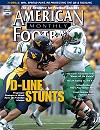AMERICAN FOOTBALL MONTHLY THE #1 RESOURCE FOR FOOTBALL COACHES
Article CategoriesAFM Magazine
|
Becoming a Complete Back: Teaching Your RBs to Protect Your QBby: Mike WilliamsAssistant Head Coach , Running Backs, University of Tennessee-Martin © More from this issue During my career I have had the privilege to coach some outstanding running backs in high school and college. I have been fortunate to coach backs who have given me their undivided attention and were excited about reaching their potential as complete running backs. Several of the backs I have had the opportunity to coach went on and played in the NFL. Tony Smith, Chris Buckhalter and Harold Shaw all had successful careers. All of these young men were good athletes but had technique and fundamental flaws when it came to being a complete back. They were good rushers and receivers but there is definitely more to being the complete back. A glaring weakness with most of the backs I’ve coached was their inability to protect the quarterback. Every offense I have been invol....The full article can only be seen by subscribers. Subscribe today!
|
|
|||||||
| HOME |
MAGAZINE |
SUBSCRIBE | ONLINE COLUMNISTS | COACHING VIDEOS |
Copyright 2025, AmericanFootballMonthly.com
All Rights Reserved





